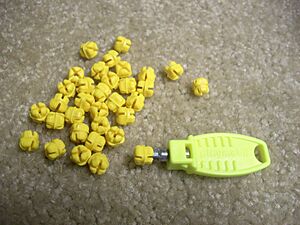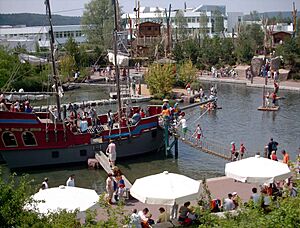Playmobil facts for kids

Logo
|
|
| Type | Plastic figures |
|---|---|
| Inventor(s) | Hans Beck |
| Company | Geobra Brandstätter GmbH |
| Country | Germany |
| Availability | 1974–present |
| Materials | |
Playmobil is a popular German toy line. It is made by the Brandstätter Group, located in Zirndorf, Germany. The most famous Playmobil toy is a 7.5 cm tall human figure. It has a friendly, smiling face.
Playmobil also includes many other items. These are accessories, buildings, vehicles, and different kinds of animals. Playmobil toys are sold in themed sets. They also come as special individual figures and playsets.
A team of about 50 people creates new Playmobil products. New toy lines are often released. Older sets are sometimes stopped. This practice has created a large group of collectors. These collectors do more than just collect. They also customize figures, play miniature wargames, and create photo stories. Some even make stop motion films or use the toys as decorations.
Contents
How Playmobil Started
Playmobil was invented by a German man named Hans Beck (1929-2009). He is known as the "Father of Playmobil." Beck first trained as a cabinetmaker. He also loved building model airplanes. He showed his airplane models to a company called Geobra Brandstätter.
Horst Brandstätter, who owned the company, asked Beck to create toy figures for children instead. The company used to make decorations and handles for caskets. Beck spent three years, from 1971 to 1974, developing Playmobil.
Beck did a lot of research. He wanted to make a toy that was not too complicated. But it also needed to be flexible enough for kids to imagine with. He thought too much flexibility would limit imagination. Too much stiffness would make kids frustrated. The toy he designed fit perfectly in a child's hand. Its face was inspired by children's drawings. It had a large head, a big smile, and no nose. Beck said, "I would put the little figures in their hands without saying anything. They accepted them right away. They invented little stories for them. They never grew tired of playing with them."
The 1973 oil crisis helped Playmobil become a successful product. Oil prices went up, which affected Geobra Brandstätter. The company needed to make products that used less plastic. Before, they made large plastic toys like hula hoops. Playmobil figures used much less plastic.
In 1974, the first Playmobil sets were shown. These included knights, Native Americans, and construction workers. At first, people were not sure about the toys. But they were shown at the Nuremberg International Toy Fair that same year. A company from the Netherlands agreed to buy a whole year's worth of production.
By the end of 1974, Playmobil sales reached 3 million Deutschmarks. This was one-sixth of the company's total sales. Playmobil began to be sold worldwide in 1975. By 2009, about 2.2 billion Playmobil figures had been sold. Playmobil has been a big competitor to Lego toys. Both companies have similar types of toys. Playmobil toys are usually very realistic. They show accurate details of clothes, tools, and armor from different time periods. Their modern construction and city life toys are especially detailed. These include cars, cranes, fire engines, trains, and boats.
Playmobil Products
Playmobil toys are made for children aged four to twelve. The company believes older children usually stop playing with these types of toys. So, they avoid making toys from less popular historical times. However, many adults collect Playmobil. They also make movies using the toys.
The first Playmobil sets featured Native Americans, construction workers, and knights.
Playmobil figures' hands were designed to hold objects. Older figures had arms made of one piece. Since 1982, all figures have hands that can also turn at the wrist. Most Playmobil figures do not have names. This lets children create their own characters and stories. Some exceptions are characters from Playmobil video games. These include Alex, Hype, and Laura.
Early figures had a hairpiece with a button shape for headgear. Later, the hairpiece was redesigned to be more rounded. This also changed the headgear. The first female figures had a different hairstyle and a wider chest piece. This wider piece suggested a skirt. Later, female figures were redesigned with more defined chests, smaller waists, and slightly thinner arms.
Most Playmobil sets need to be put together by the owner. Buildings, especially, come with detailed instructions. Playmobil building parts first used a system of tabs and slots called "Steck-System." More recently, a new building system was introduced. It uses small connector pieces and a special tool. This is called "System-X" and is now the main Playmobil building system. The Steck-System is mostly retired, except for special reissues.
Over the years, some toy ideas were not released. These included Chinese Railroad Workers and a Grave Digger for the Western theme. A Medieval Torture Room was also considered. Prototypes were made for these. However, these sets were thought to be inappropriate for young children. So, they were never sold. But there are sets with ghosts and a mummy containing a skeleton.
Playmobil also had pop-up books. These books had buildings that matched the height of Playmobil figures. There were also comic books, coloring books, and puzzles.
In early 2019, a new product called Playmobil Pro was shown. This line brought Playmobil figures into business settings. It was made for adult professionals, not children. The idea was to compete with Lego Serious Play. Playmobil Pro figures are white and have simple designs. Playmobil Pro became available in the United States in January 2020.
Licensing Playmobil
Many companies in Europe and Latin America were allowed to make and sell Playmobil figures.
In Spain, figures were made by a dollmaker called Famosa. They were sold as "los clicks de Famobil." Spanish packages listed the number of male dolls (clicks) and female dolls (clacks). Female figures had different hairstyles and a wider chest piece.
Greek figures were made in the 1970s by a company called Lyra.
In Argentina, Playmobil is licensed by Antex. They sell the toys in all South American markets. Before, Playmobil was licensed by other companies. These included Trol, Estrela, and Industria de Brinquedos do Amazonas in Brazil. In Peru, it was licensed by BASA.
From 1976 to 1980, Louis Marx and Company sold Playmobil in the United Kingdom. They used the brand name Playpeople.
Playmobil was brought to the United States by Mattel and Schaper. In 1982, Schaper arranged a special promotion. Playmobil toys were given out in McDonald's Happy Meals across the country. Five different Playmobil toys were planned for the promotion. These were a Sheriff, an Indian, a Sheriff's Horse, an Umbrella Girl, and a Farmer. About 10 million Sheriff and Indian Playmobil toys were given out from October 22 to November 1, 1982.
McDonald's stopped giving out the toys before the others were distributed. This happened after tests showed the toys did not meet safety standards. These standards prevent young children from choking on small items. The Playmobil toys were not involved in any reported choking incidents. McDonald's told customers with children under three to stop using the toys. They could return the toys for a dessert, a cone, or a refund.
In 2004, BMW made a special BMW Z4 car in Playmobil size. It came with two Playmobil passengers. To get one of these Z4s (in red or blue), you had to take a test drive at a BMW dealership in Germany. Later, yellow or light blue versions were sold in European toy stores. These were officially licensed, but not made by Playmobil. Other car brands like Mercedes-Benz, Volkswagen, Audi, Citroen, Porsche, and Mini Cooper have also done similar promotions.
Unauthorized Figures
In 1978, a German-Hungarian company called Schenk started making fake Playmobil figures. They did not have permission from geobra Brandstätter. Schenk made exact copies of the original toys. Some sets were changed to create new types of sets. These were usually military figures from Hungarian history. For example, Schenk made the Hussar from the Hungarian War of Independence. They also made Austrian soldiers, Turkish soldiers, William Tell, and figures from the Hunyadi series.
Schenk figures, like early Playmobil figures, do not have movable hands. Unlike Playmobil horses, Schenk horses do not have movable heads. Schenk figures also have different colors than Playmobil ones. They were also made with lower quality plastic. After the end of communism, a court ruled in 1995 that Schenk could not make or sell the figures anymore. The owner, Károly Schenk, was allowed to sell his remaining toys only in Hungary until March 1996. However, Schenk figures might still be found in some toy shops in Hungary.
Fake sets have also been made in China. These sets are not sold as Playmobil. But they look the same, though their quality is different. Examples include a "Noshery" (a fast food place), "Pirate Island," and medieval figures.
Playmobil Factories in Europe
There are three main Playmobil factories in Europe. They are located in Germany, Malta, and Spain. Each factory specializes in making certain parts. Then, all the parts needed for a set are sent to one location. There, they are put together and packaged for sale. Malta focuses on making the characters and some accessories. Spain specializes in accessories. Germany makes larger items like ships and castles.
Where Playmobil is Sold
New Playmobil sets are released over a two-year period. Countries that are "non-export markets" get the new sets first. Then, "export markets" receive them a year later. This helps Playmobil save money. They only need to make one expensive mold for each new piece. This mold can then produce enough toys for the first release. After that, Playmobil makes smaller amounts to restock stores as needed. If they released sets to the whole world at once, they would need two of each mold. The second mold would become useless once production slowed down.
Non-export markets:
- Germany
- Austria
- Switzerland
- Belgium
- Netherlands
- Luxembourg
- Denmark
- Sweden
- Norway
Export markets:
- All other countries
Playmobil Themes and Figures
Playmobil offers a huge variety of themes. These include Farming, Firefighters, Camping, Hospitals, Modern Homes, Preschools, Policemen, Rescue Squad, Schools, Modern Luxury Mansions, Horse Stables, Books, a Rainbow Castle, Mermaids, Santa Claus, and Tiny Houses.
There is also a Disney theme in the Jr. section for younger kids. It includes characters like Mickey and Minnie. You can also find Pooh, Piglet, and Tigger from Winnie the Pooh. Other Disney characters include Ariel and Flounder from The Little Mermaid. There's also Cinderella and Prince Charming from Cinderella. You can find Belle from Beauty and the Beast. Moana and Heihei from Moana are also available. Finally, Tinker Bell, Peter Pan, and Captain Hook from Peter Pan are part of the collection.
You can even create your own custom figures called “My Figures.” These are available on the Playmobil website.
Here is a list of themes that are currently being produced:
- Ayuma
- Christmas
- City Action
- City Life
- Color by Crayola
- Country
- Dino Rise
- Dinos
- Dollhouse
- Dragons: The Nine Realms
- FunStars
- Heroes
- History
- Horses of Waterfall
- Playmobil Jr. (for younger kids, includes “Aqua” bath toys)
- Miraculous: Tales of Ladybug & Cat Noir
- My Life
- NHL
- Naruto: Shippuden
- Novelmore
- Pirates
- Princess Magic
- Sports
- Stunt Show
- Western
- WilTopia
The fastest selling Playmobil figure is of Martin Luther. It was released to celebrate the 500-year anniversary of the Ninety-five Theses. This event started the Reformation. The first 34,000 figures sold out in just three days.
Sets also include famous vehicles. These are the Ferrari SF90 Stradale, Porsche 911, Volkswagen Type 1, and Type 2. These have been very popular in stores.
Promo packs with special themes are also available. SpecialPlus figures can include ones for holidays.
Playmobil FunParks and FunStores
Playmobil has amusement parks called FunParks. These parks have play areas and events based on Playmobil toys. There are also FunStores inside FunParks. FunStores are special Playmobil shops that sell all the current Playmobil toys.
FunPark and FunStore locations include:
- FunPark Athens, Greece (mostly toys, not as many outdoor play areas as Malta and Zirndorf)
- FunPark Ħal Far, Malta (part of the Playmobil Park factory)
- FunPark Palm Beach Gardens, Florida, US (now closed, it was the only Playmobil Funpark outside Europe)
- FunPark Fresnes, France (small, mostly toys, now closed)
- FunPark Zirndorf, Germany (next to the Playmobil headquarters)
Playmobil in Movies and TV
Playmobil figures have appeared in movies and TV shows.
- The Secret of Pirate Island (2009): This was a 3D animated interactive DVD. It was based on the Pirates theme.
- Playmobil: The Movie (2019): This was a live-action and animated movie. It was produced by French studios On Entertainment, Wild Bunch, and Pathé. The movie was directed by animator Lino DiSalvo. It was released in December 2019.
The movie did not do well at the box office. It was released only weeks after Frozen II. The movie used a special pricing strategy, offering $5 tickets. On its opening day, Playmobil earned only $167,000. This made it one of the lowest-earning opening days for a movie shown in over 2,000 theaters. It earned $660,000 on its opening weekend. This was one of the lowest opening weekends ever. One writer suggested the low box office was because the Playmobil brand is less popular than Lego.
TV Series
- Super 4 (2014): This was a CGI animated TV series. It was co-produced by Method Animation, PGS Entertainment, and Morgen Studios. The series was shown on Boomerang in Latin America, CITV in Britain, Cartoon Network in Italy, Netflix, and KidsClick in the United States.
- Novelmore (2020): A CGI animated TV series launched on the Playmobil YouTube channel and YouTube Kids. It has 26 episodes. The series is about the Knights of Novelmore and their fight for a magical armor.
- Dino Rise – The Legend of Dino Rock (2021): An animated series launched. It focuses on a group of friends who team up with a T Rex and the Keepers of Dino Rock. They work to save the world from the Comet Corporation.
- Ayuma (2021): This Playmobil series started on YouTube and YouTube Kids. It tells the story of mysterious Bat Fairies. Led by Bat Fairy Noxana, they steal crystals from Ayuma's magical energy source. The young fairies must protect their world.
- DUCK ON CALL (2022): A separate CGI animated series on YouTube and YouTube Kids. It takes young fans to Playmoville. It tells funny stories about the lovable rescuers. The first episode introduced Ducklas and the young rescue team.
Video Games
Playmobil has also inspired several video games:
- Alex Builds his Farm: A game for children aged 7-10. Players help Alex on his farm.
- Hype: The Time Quest: An adventure game set in the Knights theme.
- Laura's Happy Adventures: An adventure game set in the Doll's House theme.
- Playmobil: Knights - for Nintendo DS
- Playmobil: Pirates - for Nintendo DS
- Playmobil: Circus - for Wii
- Playmobil: Top Agents - for Nintendo DS
Images for kids
See also
 In Spanish: Playmobil para niños
In Spanish: Playmobil para niños




